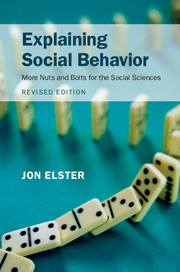6 - Myopia and foresight
from II - The Mind
Published online by Cambridge University Press: 05 August 2015
Summary
In the previous chapter I explored the relation between self and others. In the present chapter, the focus is on the relation between the present and future. In some cases, and to some extent, the analogy between other selves and future states of the self can be useful. We may, that is, look for intrapersonal and intertemporal analogies to interpersonal relations. The questions “If not me, who?” and “If not now, when?” have a common root in magical thinking (Chapter 14). Drawing on the same analogy, La Bruyère observed that “To think only of oneself and of the present time is a source of error in politics.” The economic idea of externalities has a parallel in the idea of internalities (Chapter 17). Economists sometimes treat prudence and altruism within the same conceptual framework. The problem of time inconsistency can arise in intrapersonal as well as interpersonal contexts (see Chapter 18). Although the analogy is endlessly fascinating, it has to be handled with care. It may suggest hypotheses, but does not lend them any support.
Beyond gradient climbing
Freud's pleasure principle (Chapter 4) is the tendency to seek immediate gratification of desires. One manifestation of this tendency is the adoption of the belief one would like to be true rather than the belief that is supported by the evidence. Wishful thinking makes me feel good here and now, even if it may cause me to fall flat on my face later on. Another manifestation occurs in the choice between two actions that induce different temporal utility streams. The pleasure principle dictates the choice of the stream that has the highest utility in the first period, regardless of the shape of the streams in later periods.
More generally, a decision maker, be it an earthworm or a firm, may engage in gradient climbing. At any point in time it scans the nearby options to see whether one of them yields greater immediate benefits than the status quo. The restriction to nearby options is a form of “spatial myopia”: out of sight, out of mind.
- Type
- Chapter
- Information
- Explaining Social BehaviorMore Nuts and Bolts for the Social Sciences, pp. 99 - 113Publisher: Cambridge University PressPrint publication year: 2015



